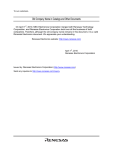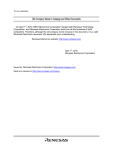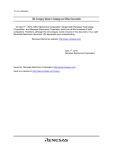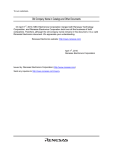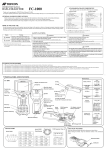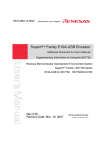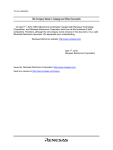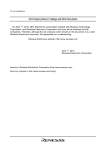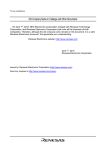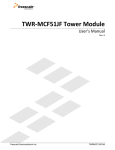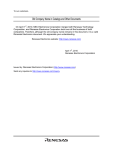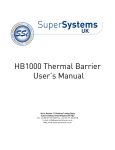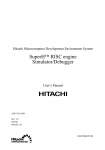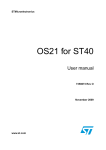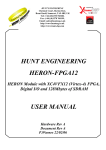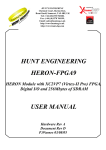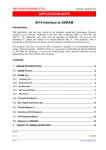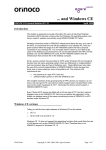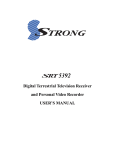Download SH7750S E10A Emulation Memory Board HS7750SEJH01H User`s
Transcript
To our customers, Old Company Name in Catalogs and Other Documents On April 1st, 2010, NEC Electronics Corporation merged with Renesas Technology Corporation, and Renesas Electronics Corporation took over all the business of both companies. Therefore, although the old company name remains in this document, it is a valid Renesas Electronics document. We appreciate your understanding. Renesas Electronics website: http://www.renesas.com April 1st, 2010 Renesas Electronics Corporation Issued by: Renesas Electronics Corporation (http://www.renesas.com) Send any inquiries to http://www.renesas.com/inquiry. Notice 1. 2. 3. 4. 5. 6. 7. All information included in this document is current as of the date this document is issued. Such information, however, is subject to change without any prior notice. Before purchasing or using any Renesas Electronics products listed herein, please confirm the latest product information with a Renesas Electronics sales office. Also, please pay regular and careful attention to additional and different information to be disclosed by Renesas Electronics such as that disclosed through our website. Renesas Electronics does not assume any liability for infringement of patents, copyrights, or other intellectual property rights of third parties by or arising from the use of Renesas Electronics products or technical information described in this document. No license, express, implied or otherwise, is granted hereby under any patents, copyrights or other intellectual property rights of Renesas Electronics or others. You should not alter, modify, copy, or otherwise misappropriate any Renesas Electronics product, whether in whole or in part. Descriptions of circuits, software and other related information in this document are provided only to illustrate the operation of semiconductor products and application examples. You are fully responsible for the incorporation of these circuits, software, and information in the design of your equipment. Renesas Electronics assumes no responsibility for any losses incurred by you or third parties arising from the use of these circuits, software, or information. When exporting the products or technology described in this document, you should comply with the applicable export control laws and regulations and follow the procedures required by such laws and regulations. You should not use Renesas Electronics products or the technology described in this document for any purpose relating to military applications or use by the military, including but not limited to the development of weapons of mass destruction. Renesas Electronics products and technology may not be used for or incorporated into any products or systems whose manufacture, use, or sale is prohibited under any applicable domestic or foreign laws or regulations. Renesas Electronics has used reasonable care in preparing the information included in this document, but Renesas Electronics does not warrant that such information is error free. Renesas Electronics assumes no liability whatsoever for any damages incurred by you resulting from errors in or omissions from the information included herein. Renesas Electronics products are classified according to the following three quality grades: “Standard”, “High Quality”, and “Specific”. The recommended applications for each Renesas Electronics product depends on the product’s quality grade, as indicated below. You must check the quality grade of each Renesas Electronics product before using it in a particular application. You may not use any Renesas Electronics product for any application categorized as “Specific” without the prior written consent of Renesas Electronics. Further, you may not use any Renesas Electronics product for any application for which it is not intended without the prior written consent of Renesas Electronics. Renesas Electronics shall not be in any way liable for any damages or losses incurred by you or third parties arising from the use of any Renesas Electronics product for an application categorized as “Specific” or for which the product is not intended where you have failed to obtain the prior written consent of Renesas Electronics. The quality grade of each Renesas Electronics product is “Standard” unless otherwise expressly specified in a Renesas Electronics data sheets or data books, etc. “Standard”: 8. 9. 10. 11. 12. Computers; office equipment; communications equipment; test and measurement equipment; audio and visual equipment; home electronic appliances; machine tools; personal electronic equipment; and industrial robots. “High Quality”: Transportation equipment (automobiles, trains, ships, etc.); traffic control systems; anti-disaster systems; anticrime systems; safety equipment; and medical equipment not specifically designed for life support. “Specific”: Aircraft; aerospace equipment; submersible repeaters; nuclear reactor control systems; medical equipment or systems for life support (e.g. artificial life support devices or systems), surgical implantations, or healthcare intervention (e.g. excision, etc.), and any other applications or purposes that pose a direct threat to human life. You should use the Renesas Electronics products described in this document within the range specified by Renesas Electronics, especially with respect to the maximum rating, operating supply voltage range, movement power voltage range, heat radiation characteristics, installation and other product characteristics. Renesas Electronics shall have no liability for malfunctions or damages arising out of the use of Renesas Electronics products beyond such specified ranges. Although Renesas Electronics endeavors to improve the quality and reliability of its products, semiconductor products have specific characteristics such as the occurrence of failure at a certain rate and malfunctions under certain use conditions. Further, Renesas Electronics products are not subject to radiation resistance design. Please be sure to implement safety measures to guard them against the possibility of physical injury, and injury or damage caused by fire in the event of the failure of a Renesas Electronics product, such as safety design for hardware and software including but not limited to redundancy, fire control and malfunction prevention, appropriate treatment for aging degradation or any other appropriate measures. Because the evaluation of microcomputer software alone is very difficult, please evaluate the safety of the final products or system manufactured by you. Please contact a Renesas Electronics sales office for details as to environmental matters such as the environmental compatibility of each Renesas Electronics product. Please use Renesas Electronics products in compliance with all applicable laws and regulations that regulate the inclusion or use of controlled substances, including without limitation, the EU RoHS Directive. Renesas Electronics assumes no liability for damages or losses occurring as a result of your noncompliance with applicable laws and regulations. This document may not be reproduced or duplicated, in any form, in whole or in part, without prior written consent of Renesas Electronics. Please contact a Renesas Electronics sales office if you have any questions regarding the information contained in this document or Renesas Electronics products, or if you have any other inquiries. (Note 1) “Renesas Electronics” as used in this document means Renesas Electronics Corporation and also includes its majorityowned subsidiaries. (Note 2) “Renesas Electronics product(s)” means any product developed or manufactured by or for Renesas Electronics. To all our customers Regarding the change of names mentioned in the document, such as Hitachi Electric and Hitachi XX, to Renesas Technology Corp. The semiconductor operations of Mitsubishi Electric and Hitachi were transferred to Renesas Technology Corporation on April 1st 2003. These operations include microcomputer, logic, analog and discrete devices, and memory chips other than DRAMs (flash memory, SRAMs etc.) Accordingly, although Hitachi, Hitachi, Ltd., Hitachi Semiconductors, and other Hitachi brand names are mentioned in the document, these names have in fact all been changed to Renesas Technology Corp. Thank you for your understanding. Except for our corporate trademark, logo and corporate statement, no changes whatsoever have been made to the contents of the document, and these changes do not constitute any alteration to the contents of the document itself. Renesas Technology Home Page: http://www.renesas.com Renesas Technology Corp. Customer Support Dept. April 1, 2003 Cautions Keep safety first in your circuit designs! 1. Renesas Technology Corporation puts the maximum effort into making semiconductor products better and more reliable, but there is always the possibility that trouble may occur with them. Trouble with semiconductors may lead to personal injury, fire or property damage. Remember to give due consideration to safety when making your circuit designs, with appropriate measures such as (i) placement of substitutive, auxiliary circuits, (ii) use of nonflammable material or (iii) prevention against any malfunction or mishap. Notes regarding these materials 1. These materials are intended as a reference to assist our customers in the selection of the Renesas Technology Corporation product best suited to the customer's application; they do not convey any license under any intellectual property rights, or any other rights, belonging to Renesas Technology Corporation or a third party. 2. Renesas Technology Corporation assumes no responsibility for any damage, or infringement of any third-party's rights, originating in the use of any product data, diagrams, charts, programs, algorithms, or circuit application examples contained in these materials. 3. All information contained in these materials, including product data, diagrams, charts, programs and algorithms represents information on products at the time of publication of these materials, and are subject to change by Renesas Technology Corporation without notice due to product improvements or other reasons. It is therefore recommended that customers contact Renesas Technology Corporation or an authorized Renesas Technology Corporation product distributor for the latest product information before purchasing a product listed herein. The information described here may contain technical inaccuracies or typographical errors. Renesas Technology Corporation assumes no responsibility for any damage, liability, or other loss rising from these inaccuracies or errors. Please also pay attention to information published by Renesas Technology Corporation by various means, including the Renesas Technology Corporation Semiconductor home page (http://www.renesas.com). 4. When using any or all of the information contained in these materials, including product data, diagrams, charts, programs, and algorithms, please be sure to evaluate all information as a total system before making a final decision on the applicability of the information and products. Renesas Technology Corporation assumes no responsibility for any damage, liability or other loss resulting from the information contained herein. 5. Renesas Technology Corporation semiconductors are not designed or manufactured for use in a device or system that is used under circumstances in which human life is potentially at stake. Please contact Renesas Technology Corporation or an authorized Renesas Technology Corporation product distributor when considering the use of a product contained herein for any specific purposes, such as apparatus or systems for transportation, vehicular, medical, aerospace, nuclear, or undersea repeater use. 6. The prior written approval of Renesas Technology Corporation is necessary to reprint or reproduce in whole or in part these materials. 7. If these products or technologies are subject to the Japanese export control restrictions, they must be exported under a license from the Japanese government and cannot be imported into a country other than the approved destination. Any diversion or reexport contrary to the export control laws and regulations of Japan and/or the country of destination is prohibited. 8. Please contact Renesas Technology Corporation for further details on these materials or the products contained therein. User’s Manual SH7750S E10A Emulation Memory Board (HS7750SEJH01H) User’s Manual Rev.1.0 2002.09 Cautions 1. Hitachi neither warrants nor grants licenses of any rights of Hitachi’s or any third party’s patent, copyright, trademark, or other intellectual property rights for information contained in this document. Hitachi bears no responsibility for problems that may arise with third party’s rights, including intellectual property rights, in connection with use of the information contained in this document. 2. Products and product specifications may be subject to change without notice. Confirm that you have received the latest product standards or specifications before final design, purchase or use. 3. Hitachi makes every attempt to ensure that its products are of high quality and reliability. However, contact Hitachi’s sales office before using the product in an application that demands especially high quality and reliability or where its failure or malfunction may directly threaten human life or cause risk of bodily injury, such as aerospace, aeronautics, nuclear power, combustion control, transportation, traffic, safety equipment or medical equipment for life support. 4. Design your application so that the product is used within the ranges guaranteed by Hitachi particularly for maximum rating, operating supply voltage range, heat radiation characteristics, installation conditions and other characteristics. Hitachi bears no responsibility for failure or damage when used beyond the guaranteed ranges. Even within the guaranteed ranges, consider normally foreseeable failure rates or failure modes in semiconductor devices and employ systemic measures such as fail-safes, so that the equipment incorporating Hitachi product does not cause bodily injury, fire or other consequential damage due to operation of the Hitachi product. 5. This product is not designed to be radiation resistant. 6. No one is permitted to reproduce or duplicate, in any form, the whole or part of this document without written approval from Hitachi. 7. Contact Hitachi’s sales office for any questions regarding this document or Hitachi semiconductor products. IMPORTANT INFORMATION READ FIRST • READ this user's manual before using this emulation memory board. • KEEP the user's manual handy for future reference. Do not attempt to use the emulation memory board until you fully understand its mechanism. Emulation Memory Board: Throughout this document, the term "emulation memory board" shall be defined as the following products produced only by Hitachi, Ltd. excluding all subsidiary products. • • Emulation memory board Power cables supplied together with this emulation memory board The user system or a host computer is not included in this definition. Purpose of the Emulation Memory Board: This emulation memory board is an optional board for supporting the development of the systems using the SH7750S. This memory board must only be used for the above purpose. Limited Applications: This emulation memory board is not authorized for use in MEDICAL, atomic energy, aeronautical or space technology applications without consent of the appropriate officer of a Hitachi sales company. Such use includes, but is not limited to, use in life support systems. Buyers of this emulation memory board must notify the relevant Hitachi sales offices before planning to use the product in such applications. Improvement Policy: Hitachi, Ltd. (including its subsidiaries, hereafter collectively referred to as Hitachi) pursues a policy of continuing improvement in design, functions, performance, and safety of the emulation memory board. Hitachi reserves the right to change, wholly or partially, the specifications, design, user's manual, and other documentation at any time without notice. Target User of the Emulation Memory Board: This emulation memory board should only be used by those who have carefully read and thoroughly understood the information and restrictions contained in the user's manual. Do not attempt to use the emulation memory board until you fully understand its mechanism. It is highly recommended that first-time users be instructed by users that are well versed in the operation of the emulation memory board. i LIMITED WARRANTY Hitachi warrants its emulation memory boards to be manufactured in accordance with published specifications and free from defects in material and/or workmanship. Hitachi, at its option, will repair or replace any emulation memory boards returned intact to the factory, transportation charges prepaid, which Hitachi, upon inspection, determine to be defective in material and/or workmanship. The foregoing shall constitute the sole remedy for any breach of Hitachi's warranty. See the Hitachi warranty booklet for details on the warranty period. This warranty extends only to you, the original Purchaser. It is not transferable to anyone who subsequently purchases the emulation memory board from you. Hitachi is not liable for any claim made by a third party or made by you for a third party. DISCLAIMER HITACHI MAKES NO WARRANTIES, EITHER EXPRESS OR IMPLIED, ORAL OR WRITTEN, EXCEPT AS PROVIDED HEREIN, INCLUDING WITHOUT LIMITATION THEREOF, WARRANTIES AS TO MARKETABILITY, MERCHANTABILITY, FITNESS FOR ANY PARTICULAR PURPOSE OR USE, OR AGAINST INFRINGEMENT OF ANY PATENT. IN NO EVENT SHALL HITACHI BE LIABLE FOR ANY DIRECT, INCIDENTAL OR CONSEQUENTIAL DAMAGES OF ANY NATURE, OR LOSSES OR EXPENSES RESULTING FROM ANY DEFECTIVE EMULATION MEMORY BOARD, THE USE OF ANY EMULATION MEMORY BOARD, OR ITS DOCUMENTATION, EVEN IF ADVISED OF THE POSSIBILITY OF SUCH DAMAGES. EXCEPT AS EXPRESSLY STATED OTHERWISE IN THIS WARRANTY, THIS EMULATION MEMORY BOARD IS SOLD "AS IS ", AND YOU MUST ASSUME ALL RISK FOR THE USE AND RESULTS OBTAINED FROM THE EMULATION MEMORY BOARD. ii State Law: Some states do not allow the exclusion or limitation of implied warranties or liability for incidental or consequential damages, so the above limitation or exclusion may not apply to you. This warranty gives you specific legal rights, and you may have other rights which may vary from state to state. The Warranty is Void in the Following Cases: Hitachi shall have no liability or legal responsibility for any problems caused by misuse, abuse, misapplication, neglect, improper handling, installation, repair or modifications of the emulation memory board without Hitachi's prior written consent or any problems caused by the user system. All Rights Reserved: This user's manual and emulation memory board are copyrighted and all rights are reserved by Hitachi. No part of this user's manual, all or part, may be reproduced or duplicated in any form, in hard-copy or machine-readable form, by any means available without Hitachi's prior written consent. Other Important Things to Keep in Mind: 1. Circuitry and other examples described herein are meant merely to indicate the characteristics and performance of Hitachi's semiconductor products. Hitachi assumes no responsibility for any intellectual property claims or other problems that may result from applications based on the examples described herein. 2. No license is granted by implication or otherwise under any patents or other rights of any third party or Hitachi. Figures: Some figures in this user's manual may show items different from your actual system. Limited Anticipation of Danger: Hitachi cannot anticipate every possible circumstance that might involve a potential hazard. The warnings in this user's manual and on the emulation memory board are therefore not all inclusive. Therefore, you must use the emulation memory board safely at your own risk. iii SAFETY PAGE READ FIRST • READ this user's manual before using this emulation memory board. • KEEP the user's manual handy for future reference. Do not attempt to use the emulation memory board until you fully understand its mechanism. DEFINITION OF SIGNAL WORDS This is the safety alert symbol. It is used to alert you to potential personal injury hazards. Obey all safety messages that follow this symbol to avoid possible injury or death. DANGER WARNING CAUTION CAUTION DANGER indicates an imminently hazardous situation which, if not avoided, will result in death or serious injury. WARNING indicates a potentially hazardous situation which, if not avoided, could result in death or serious injury. CAUTION indicates a potentially hazardous situation which, if not avoided, may result in minor or moderate injury. CAUTION used without the safety alert symbol indicates a potentially hazardous situation which, if not avoided, may result in property damage. NOTE emphasizes essential information. iv WARNING Observe the precautions listed below. Failure to do so will result in a FIRE HAZARD and will damage the user system, the emulation memory board, and the emulator product or will result in PERSONAL INJURY. The USER PROGRAM will be LOST. 1. Do not repair or remodel the emulation memory board by yourself for electric shock prevention and quality assurance. 2. Always switch OFF the emulator product, the emulation memory board, and the user system before connecting or disconnecting any CABLES or JUMPERS. 3. Always switch OFF the emulation memory board and the user system before connecting or disconnecting the IC socket or the user system interface connector. 4. When connecting the user system interface connector to the IC socket on the user system, ensure that pin 1 on both sides are correctly aligned. 5. Supply power according to the power specifications and do not supply an incorrect power voltage. Use only the provided power cables. v Warnings on Emulation Memory Board Usage Be sure to read and understand the warnings below before using this emulation memory board. Note that these are the main warnings, not a complete list. WARNING Always switch OFF the emulator product, the emulation memory board, and the user system before connecting or disconnecting any CABLES, JUMPERS, or PARTS. Failure to do so will result in a FIRE HAZARD and will damage the emulator product, the emulation memory board, or the user system, or will result in PERSONAL INJURY. The USER PROGRAM will be LOST. CAUTION Position the emulator product, the emulation memory board, and the user system so that no cable is bent or twisted. A bent or twisted cable will impose stress on the user system interface leading to connection or contact failure. Make sure that the emulation memory board is placed in a secure position so that it does not move during use nor impose stress on the user system interface. vi Preface Thank you for purchasing the SH7750S E10A emulation memory board. The emulation memory board supports the development of systems using Hitachi microcomputer SH7750S. Read this user's manual before using the emulation memory board, and keep the manual handy for future reference. CAUTION READ this user's manual before using the emulation memory board. Incorrect operation or connection will damage the emulation memory board and the user system. The USER PROGRAM will be LOST. Related Manuals: • SH7750 Series Hardware Manual • SH7750 E10A Emulator User's Manual Related Hardware: SH7750 E10A Emulators • HS7750KCM01H • HS7750KCI01H vii viii Contents Section 1 Overview..............................................................................................1 1.1 1.2 Features ............................................................................................................................. 1 Components ...................................................................................................................... 2 Section 2 Notes on Use ........................................................................................3 Section 3 Emulation Memory Board Functions...................................................5 Section 4 Emulation Memory Board Operation ..................................................7 4.1 4.2 Switch Setting ................................................................................................................... 8 4.1.1 Power Source Switch Setting............................................................................... 8 4.1.2 Jumper Switch Setting ......................................................................................... 8 4.1.3 DIP Switch (SW2) Setting ................................................................................... 10 4.1.4 RESET Switch (SW1).......................................................................................... 13 Monitor LEDs ................................................................................................................... 14 Section 5 Connection Procedures ........................................................................15 5.1 5.2 5.3 5.4 Connecting Emulation Memory Board to Emulator and User System ............................. 15 Operating Emulation Memory Board Without Connecting User System ......................... 21 Disconnecting Emulation Memory Board from User System........................................... 23 Recommended Dimensions for User System Mount Pad ................................................. 24 Section 6 Limitations ...........................................................................................25 6.1 Limitations on User System .............................................................................................. 25 Section 7 User System Interface ..........................................................................27 7.1 7.2 Pin Assignment and Handling of User System Interface Signals ..................................... 27 Signal Line Handling on the Emulation Memory Board and User System ...................... 31 Section 8 Emulation Memory Board Block Diagram..........................................33 ix x Section 1 Overview The SH7750S E10A emulation memory board (hereinafter referred to as the emulation memory board) has an SH7750S (hereafter referred to as the MCU), interface connectors (H-UDI port connectors) for the E10A emulator (hereinafter called the emulator), a user system interface connector, and SRAM devices. User programs can be emulated by connecting this emulation memory board to the emulator. 1.1 Features 1. The emulation memory board has emulator connectors and a user system interface connector (YQPACK208SD). When the user system has an IC socket (NQPACK208SD) but has no HUDI connector, the user system can be connected to the emulator through the emulation memory board and the user program can be emulated. 2. The emulation memory board has SRAM devices that can be used as a substitute for the flash memory or EPROM devices. User programs can be emulated by connecting the emulation memory board to the emulator and supplying external power to the emulation memory, even when no user system is connected to the emulator. 3. The emulation memory board has switches for various settings. These switches can select (1) the source of the power supplied to the emulation memory board, (2) the source of the clock supplied to the MCU on the emulation memory board, and (3) the destination of the CS0 signal output from the MCU. 4. The emulation memory board has a DIP switch, which can set the MCU's MD terminal status. 1 1.2 Components Figure 1.1 and table 1.1 show the components of the emulation memory board. Please make sure you have all of these components when unpacking. Emulation memory board (HS7750SEJH01H) Pin 1 mark Power cable Emulator connector User system interface connector Spacers Figure 1.1 Emulation Memory Board Appearance Table 1.1 Emulation Memory Board Components (HS7750SEJH01H) Item Quantity Notes Emulation memory board 1 Power cables (2 cables for 5 V and 2 cables for GND) 1 set For an external power supply Screws (M2 x 10 mm) 4 For fastening user system interface connector NQPACK208SD 1 Connector for interfacing with the user system Guide pins for NQPACK208SD 3 For determining the connector location Screwdriver 1 For tightening screws Spacers (13 mm) 4 Fixed to the emulation memory board SH7750S E10A Emulation Memory Board User's Manual 1 This manual 2 Section 2 Notes on Use CAUTION READ the following warnings before using the emulation memory board. Incorrect operation will damage the emulation memory board, the user system, and the emulator product. The USER PROGRAM will be LOST. 1. Cover the emulation memory board with a casing before using it. If using the emulation memory board without a casing, do not touch any component and prevent any short circuit. 2. Never place heavy objects on the emulation memory board. 3. Protect the emulation memory board from excessive impacts and stresses. 4. Do not supply power outside the specified voltage range. 5. When moving the emulation memory board, take care not to vibrate or damage it. 6. Supply power to the connected equipment only after connecting all cables. Cables must not be connected or removed while the power is on. 7. The emulation memory board may operate incorrectly due to static electricity. In this case, connect the GND patterns (the spacer-fixed sections at the four corners) on the emulation memory board to those of the user system through cables to discharge static electricity. 8. The emulation memory board can operate only when connected to the emulator; the emulation memory board cannot be used alone or only by connecting to the user system. 3 4 Section 3 Emulation Memory Board Functions The functions of the emulation memory board are listed in table 3.1. Table 3.1 Emulation Memory Board Functions Function Specifications CPU clock • Independently using emulation memory board without connecting the user system. Iö(CPU clock) = 200MHz(max) • Connecting emulation memory board to the user system. Iö(CPU clock) = 167MHz(max) Substitution emulation memory • Capacity: 4 Mbytes (8 blocks of 256 kwords x 16 bits) • ? Independently used (disconnecting emulation memory board to the user system) 100MHz(Max.) = B (bus clock): Three wait cycles inserted by WCR2 ? Connected (connecting emulation memory board to the user system) 66MHz(Max.) = B (bus clock): Two wait cycles inserted by WCR2 • Can be allocated to the CS0 area (Substitution memory area: H’00000000 to H’003FFFFF) • Data bus width can be selected from 16, 32, or 64 bits (8-bit width is not supported) User interface Supported package: 208 pin QFP Crystal oscillator Supported frequency for crystal oscillation: 9 MHz to 20 MHz Switch settings • SW3: Selects the power source • JP1: Selects the clock source • JP2: Selects the CS0 signal output destination DIP switch settings • SW2-1 to SW2-3: Selects the clock operating mode • SW2-4 and SW2-5: Selects the memory bus width • SW2-6: Selects the endian • SW2-7: Selects the memory type of area 0 • SW2-8: Selects the master or slave mode • SW2-9: Selects whether or not to use crystal oscillator RESET switch SW1: Issues a RESET signal LEDs • LED1: RESET and POWER • LED2: SHRDY and U-RUN • LED3: BREQ and NMI • LED4: STATUS1 and STATUS0 5 Table 3.2 Emulation Memory Board Functions (cont) Function Specifications Power supply • The emulation memory board can operate without connecting the user system by supplying +5 V through power connector J1 (IL-4P-S3FP2: manufactured by Japan Aviation Electronics Industry, Ltd.) The power connector pins work as follows: Pin 1: GND (black) Pin 2: 5 V (red ) Pin 3: 5 V (red) Pin 4: GND (black) • When the emulation memory board is connected to the user system, supply +3.3 V from the VDDQ pin on the YQPACK208SD connector, respectively. Notes: 1. For the substitution emulation memory, a 16-bit bus, a 32-bit bus, and a 64-bit bus are supported. Do not set the bus width to 8 bits when using the substitution emulation memory. 2. When allocating substitution emulation memory to area 0, set BCR1 of the bus state controller so that area 0 becomes the normal memory space (SRAM). 3. When allocating substitution emulation memory to an area, set WCR2 of the bus state controller to provide an appropriate cycle access state. CAUTION Restriction on Buffer Control Using the RD Signal: RD signal output cannot be disabled from the emulator. Consequently, when the buffer control on the user system uses only the RD signal, data read from this emulation memory board and data output from the buffer may conflict. For this reason, when using the emulation memory board, be sure to control the data bus buffer of the user system with both the CS and RD (used in direction control) signals. 6 Section 4 Emulation Memory Board Operation The emulation memory board has a RESET switch (SW1) for issuing a reset signal, a DIP switch (SW2) and jumper switches (JP1 and JP2) for various settings, a switch (SW3) for selecting the power source, a socket (SP1) for installing a crystal oscillator, and LEDs for signal monitoring. Figure 4.1 shows the switches, socket, and LEDs. 1 1 3 JP2 SP1 JP1 HS7750SEJH01H/2 USER SW3 EML 10 9 8 7 6 4 3 2 1 5 SW2 J1 3 LED1 LED2 LED3 LED4 SW1 Figure 4.1 Switches, Socket, and LEDs 7 4.1 Switch Setting 4.1.1 Power Source Switch Setting The SW3 selects whether the power for the emulation memory board is supplied from an external source or through the user system interface. WARNING Always switch OFF the user system and the emulation memory board before power source switch setting. Failure to do so will damage the user system and the emulation memory board. The USER PROGRAM will be LOST. To supply power from an external source (sliding the switch to EML): USER SW3 EML To supply power through the user system interface (sliding the switch to USER): USER SW3 EML 4.1.2 Jumper Switch Setting The emulation memory board has two jumper switches JP1 and JP2 for the following settings. JP1 Function: The JP1 selects whether the clock for the MCU is supplied from the emulation memory board or from the user system. When installing a crystal oscillator into the socket (SP1) on the emulation memory board, open JP1. In this case, set the jumper connector on pin 3 as shown below so that the jumper connector will not be lost. To supply the clock from the emulation memory board: JP1 1 3 To supply the clock from the user system: JP1 1 3 To install a crystal oscillator into the SP1 socket on the emulation memory board (JP1 is open): JP1 1 3 8 Notes: 1. When closing 1-2 pins or 2-3 pins of JP1, turn switch 9 of SW2 ON (see table 4.6). When leaving JP1 open (installing a crystal oscillator), turn switch 9 of SW2 OFF. 2. The emulation memory board supports the external clock input through the EXTAL pin and the clock generated by the crystal oscillator connected to the EXTAL and XTAL pins. Therefore, be sure to supply the clock to the EXTAL pin when using the user system clock. If the clock is supplied to the XTAL, EXTAL2, or XTAL2 pin, the emulation memory board cannot operate. JP2 Function: The JP2 selects the CS0 signal output destination to specify whether the substitution memory on the emulation memory board or the memory of the user system is used. CAUTION 1. Restriction on Buffer Control Using the RD Signal: RD signal output cannot be disabled from the emulator. Consequently, when the buffer control on the user system uses only the RD signal, data read from this emulation memory board and data output from the buffer may conflict. For this reason, when using the emulation memory board, be sure to control the data bus buffer of the user system with both the CS and RD (used in direction control) signals. 2. The substitution emulation memory is allocated to the 4 Mbytes from the start address of area 0. If the memory of the user system is allocated to area 0, that is, the same area as the substitution emulation memory, only the memory selected by the JP2 setting is used. When the substitution emulation memory is selected by JP2, the CS0 signal is not output to the user system. To use the substitution memory on the emulation memory board: JP2 1 3 To use the memory of the user system: JP2 1 3 9 4.1.3 DIP Switch (SW2) Setting The emulation memory board has one DIP switch for the following settings. • Selecting the clock operating mode: Three switches • Selecting the memory bus width: Two switches • Selecting the endian: One switch • Selecting the memory type of area 0: One switch • Selecting the master or slave mode: One switch • Selecting whether or not to install crystal oscillator: One switch Note: For details on the mode control terminals (MD0 to MD8), refer to the SH7750 Series Hardware Manual. CAUTION O N When a user system is connected to the emulation memory board, the DIP switch (SW2) settings are ignored, and the MD0 to MD8 signals input to the user system are used. 1 2 3 4 5 6 7 8 9 0 ON OFF Figure 4.2 DIP Switch (SW2) Appearance and Settings at Shipment Clock Operating Mode Setting: Select the clock operating mode as shown in table 4.1. 10 Table 4.1 Clock Operating Mode Setting (Switches 1 to 3 in SW2) Switches in SW2 (Corresponding Mode Pins) 1 (MD0) 2 (MD1) 3 (MD2) Clock Mode Remarks ON ON ON 0 Initial setting at shipment OFF ON ON 1 ON OFF ON 2 OFF OFF ON 3 ON ON OFF 4 OFF ON OFF 5 Memory Bus Width Setting: Select the memory bus width for area 0 as shown in table 4.2. Table 4.2 Memory Bus Width Setting (Switches 4 and 5 in SW2) Switches in SW2 (Corresponding Mode Pins) 4 (MD3) 5 (MD4) Memory Bus Width Remarks OFF ON 8 bits Do not use this setting ON OFF 16 bits OFF OFF 32 bits ON ON 64 bits Initial setting at shipment Note: The substitution emulation memory does not support the 8-bit bus width. Endian Setting: Select the endian as shown in table 4.3. Table 4.3 Endian Setting (Switch 6 in SW2) Switch in SW2 (Corresponding Mode Pin) 6 (MD5) Endian Remarks ON Big endian Initial setting at shipment OFF Little endian 11 Memory Type Setting for Area 0: Select the memory type of area 0 as shown in table 4.4. Table 4.4 Memory Type Setting for Area 0 (Switch 7 in SW2) Switch in SW2 (Corresponding Pin) 7 (MD6) Memory Type ON MPX bus type OFF Normal memory type Remarks Initial setting at shipment Note: When using the substitution emulation memory board, set this switch to OFF. Master or Slave Mode Setting: Select the master or slave mode as shown in table 4.5. Table 4.5 Master or Slave Mode Setting (Switch 8 in SW2) Switch in SW2 (Corresponding Pin) 8 (MD7) Master or Slave Mode ON Slave mode OFF Master mode Remarks Initial setting at shipment Crystal Oscillator Setting: Select whether or not to install a crystal oscillator as shown in table 4.6. WARNING Always switch OFF the user system and the emulation memory board before installing or uninstalling the crystal oscillator to/from the SP1 socket. Failure to do so will damage the user system, the emulation memory board, and the crystal oscillator. The USER PROGRAM will be LOST. Table 4.6 Crystal Oscillator Setting (Switch 9 in SW2) Switch in SW2 (Corresponding Pin) 9 (MD8) Crystal Oscillator Remarks ON Not installed Initial setting at shipment OFF Installed Note: When setting this switch to ON, do not open JP1. When setting this switch to OFF, be sure to install a crystal oscillator into the SP1 socket on the emulation memory board. 12 SEL Switch: Table 4.7 SEL Switch (Switch 0 in SW2) Switch in SW2 (Corresponding Pin) 0 (-) Function Remarks ON Reserved Initial setting at shipment OFF Reserved Note: Switch 0 in the SW2 is reserved. Use the initial setting at shipment and do not change it. 4.1.4 RESET Switch (SW1) The emulation memory board has RESET switch for issuing a reset signal. The /RESETP signal to the MCU is obtained by ORing the reset signal from the RESET switch, that from the power-on reset circuit on the emulation memory board, and the /RESETP signal from the user system. The manual reset, on the other hand, is done using only the /RESETM signal from the user system. Figure 4.3 shows the logic diagram for the reset circuit. MCU User system interface /RESETM /RESETM /RESETP /RESETP RESET switch SW1 Power-on reset circuit Figure 4.3 Reset Circuit Logic Diagram 13 4.2 Monitor LEDs The emulation memory board has LEDs for monitoring the operating state. Table 4.8 shows the LEDs and the states to be monitored. For details on STATUS1 and STATUS0 signals, refer to the SH7750 Series Hardware Manual. Table 4.8 LEDs and States to Be Monitored Green LED lit when /RDY is asserted U-RUN Red LED lit when in USER RUN state BREQ Green LED lit when /BREQ is asserted NMI Red LED lit when /NMI is asserted STATUS1 Green LED lit when STATUS1 is 0 (low) STATUS0 Red LED lit when STATUS0 is 0 (low) Signal: ASEBRKAK 0 9 LED4 Remarks RESET POWER SHRDY U-RUN BREQ NMI STATUS1 STATUS0 LED3 8 Red LED lit when power is supplied SHRDY 7 POWER LED2 6 Green LED lit when /RESETP is asserted 5 RESET 4 LED1 3 LED Status 2 Indication on the Board 1 LED LED1 LED2 LED3 LED4 Figure 4.4 LED Location and Indication on the Board 14 Section 5 Connection Procedures 5.1 Connecting Emulation Memory Board to Emulator and User System Be sure to switch off the emulator and user system before connecting the emulation memory board, emulator, and user system. Do not supply power to the power connector on the emulation memory board when using the user system. WARNING Observe the precautions listed below. Failure to do so will result in a FIRE HAZARD and will damage the user system, the emulation memory board, and the emulator product or will result in PERSONAL INJURY. The USER PROGRAM will be LOST. 1. Always switch OFF the emulator product, the emulation memory board, and the user system before connecting the EMULATOR PRODUCT, EMULATION MEMORY BOARD, or USER SYSTEM. 2. DO NOT supply power to the emulation memory board power connector (J1) when the emulation memory board is connected to the user system. When connected to the user system, the emulation memory board receives power from the VDDQ pin of the IC socket (NQPACK208SD) and operates by the user system power. 15 Connecting Emulation Memory Board to Emulator: Connect the emulator to the CN1 connector on the emulation memory board through an E10A emulator user system interface cable. For details on the connection procedure, refer to the SH7750 E10A Emulator User’s Manual. 1 1 3 10 9 8 7 6 5 4 3 2 1 HS7750SEJH01H/2 CN1 Figure 5.1 Connectors for Emulator 16 3 Connecting Emulation Memory Board to User System: Follow the instructions below. WARNING Observe the precautions listed below. Failure to do so will result in a FIRE HAZARD and will damage the user system, the emulation memory board, and the emulator product or will result in PERSONAL INJURY. The USER PROGRAM will be LOST. 1. Always switch OFF the emulator product, the emulation memory board, and the user system before connecting the EMULATOR PRODUCT, EMULATION MEMORY BOARD, or USER SYSTEM. 2. Use the recommended IC socket on the user system. Otherwise, excessive force will be applied to the emulation memory board and the user system when the emulation memory board is connected to or disconnected from the user system. CAUTION 1. Use NQPACK208SD (manufactured by Tokyo Eletech Corporation) as the QFP208 IC socket on the user system. 2. To mount the MCU directly on the NQPACK208SD socket, a socket cover must be used. Separately purchase HQPACK208SD (manufactured by Tokyo Eletech Corporation). 17 1. Confirm that the pins of the YQPACK connector on the emulation memory board are not bent. 2. Align pin 1 of the YQPACK connector on the emulation memory board with pin 1 of the NQPACK socket on the user system, and insert the connector into the socket. CAUTION The structures of the YQPACK connector and NQPACK socket prevent the connector from being fully inserted in the wrong direction. If the connector cannot be inserted fully, pin 1 on the connector and that on the socket may not be aligned correctly. Check the pin 1 locations on the connector and socket and re-insert the YQPACK connector. 3. After inserting the YQPACK connector on the emulation memory board into the NQPACK socket of the user system, fix the emulation memory board in place with the supplied screws, as shown in figure 5.2. CAUTION 1. Use the supplied screwdriver. 2. The tightening torque must be 0.054 N•m or less. Stop tightening when the force required to turn the screw becomes significantly greater than that needed when first tightening. 3. If a screw is tightened too much, the screw head may break or an IC socket contact error may be caused by a crack in the IC socket solder. 4. If the emulator does not operate correctly, cracks might have occurred in the solder. Check conduction with a tester and re-solder the IC socket if necessary. 18 Screws Emulation memory board Pin 1 mark YQPACK208SD Pin 1 mark NQPACK208SD User system Figure 5.2 Connecting Emulation Memory Board to User System 19 Power Supply Specifications: When the user system is connected, the emulation memory board operates by the user system power. Supply the user system power according to the specifications and rising timing shown in table 5.1 and figure 5.3. CAUTION 1. Check that the SW3 switch is set to the power supply through the user system interface, and supply 3.3-V power to the VDDQ pin. Do not supply power to the power connector (J1) on the emulation memory board. When power is supplied through the user system interface (YQPACK), only 3.3-V power should be supplied from the user system, and the emulation memory board generates 1.95-V power from the 3.3-V power. Therefore, the VDD pin (1.95 V) of the user system interface (YQPACK) is not connected to the MCU on the emulation memory board. 2. Table 5.1 Power Supply Specifications Allowable Power Range Current Consumption + 3.3 VDC ± 5% 2.0 A (max.) Ta + 3.3 V Ta 0V Figure 5.3 Characteristics of DC Rising Timing 20 50 ms 5.2 Operating Emulation Memory Board Without Connecting User System Be sure to switch off the emulator and emulation memory board before connecting them together and before connecting the power cables to the emulation memory board. WARNING Always switch OFF the emulator product and the emulation memory board before connecting the EMULATOR PRODUCT, EMULATION MEMORY BOARD, or POWER CABLES. Failure to do so will result in a FIRE HAZARD and will damage the emulator product and the emulation memory board or will result in PERSONAL INJURY. The USER PROGRAM will be LOST. Connecting to the Emulator: Connect the emulation memory board to the emulator by using the same procedure as in section 5.1, Connecting Emulation Memory Board to Emulator and User System. Connecting the Power Cables: After making sure the alignment is correct, connect the provided power cables to the power connector (J1) on the emulation memory board to supply power, as shown in figure 5.4. (The power cable and connector structures will prevent the power cables from being connected in the wrong direction.) Note that the red cables are for 5-V power and the black ones are for GND; connect them to the DC power source correctly. WARNING Be sure to connect the power cables to the DC power source correctly, that is, the red cables to the 5-V power and the black ones to GND. Failure to do so will result in a FIRE HAZARD and will damage the emulator product and the emulation memory board or will result in PERSONAL INJURY. The USER PROGRAM will be LOST. 21 Emulation memory board (HS7750SEJH01H) Pin 1 mark 1: GND (black) 4: GND (black) Power connector (J1) 2: 5 V (red) 3: 5 V (red) Power cable Figure 5.4 Connecting Power Cables to Power Connector Power Supply Specifications: Table 5.2 shows the power supply specifications, and figure 5.5 shows the rising timing of the power. Table 5.2 Power Supply Specifications Allowable Power Range Current Consumption + 5.0 VDC ± 5% 2.0 A (max.) Tc + 5.0 V Tc 0V Figure 5.5 Characteristics of DC Rising Timing 22 60 ms 5.3 Disconnecting Emulation Memory Board from User System Be sure to switch off the emulator and user system before disconnection. WARNING Always switch OFF the emulator product, the emulation memory board, and the user system before disconnecting the EMULATOR PRODUCT, EMULATION MEMORY BOARD, or USER SYSTEM. Failure to do so will result in a FIRE HAZARD and will damage the emulator product, the emulation memory board, and the user system or will result in PERSONAL INJURY. The USER PROGRAM will be LOST. Disconnecting Emulation Memory Board from User System: Follow the instructions below. 1. Remove the screws that connect the YQPACK connector and the NQPACK socket. 2. After removing all screws, remove the emulation memory board from the user system, taking care not to bend any of the pins. Screws Emulation memory board Pin 1 mark YQPACK208SD NQPACK208SD User system Figure 5.6 Disconnecting Emulation Memory Board 23 5.4 Recommended Dimensions for User System Mount Pad Figure 5.7 shows the recommended dimensions for the mount pad (footprint) for the user system with an IC socket for a QFP208 package (NQPACK208SD: manufactured by Tokyo Eletech Corporation). Note that the dimensions in figure 5.7 are somewhat different from those of the actual chip's mount pad. 31.0 min 27.0 max 0.5 0.05 2.0 0.1 0.25 0.05 12.0 0.1 0.1 0.5 51 = 25.5 12.0 0.1 0.1 0.5 0.05 0.5 51 = 25.5 3- 1.0 (For determining the socket location) Unit: mm Figure 5.7 Recommended Dimensions for Mount Pad 24 Section 6 Limitations 6.1 Limitations on User System To use the emulation memory board together with the user system, do not mount any components in the mount-prohibited areas (figure 6.1) of the user system. If any component is mounted on any of these areas, remove the corresponding spacer from the emulation memory board. In this case, take special care not to give any stress to the user system interface section (NQPACK). The height of the mounted components must be 8.0 mm or shorter in the height-limited area (figure 6.1) of the user system. If any component in this area is higher than 8.0 mm, the emulation memory board cannot be connected to the user system. 85.09 33.02 Pin 1 NQPACK center 8.00 44.36 Mount-prohibited area NQPACK location Height-limited area: 8.0 mm or shorter Unit: mm Tolerance: ± 0.20 mm 120.65 8.00 Figure 6.1 Mount-Prohibited and Height-Limited Areas of User System 25 26 Section 7 User System Interface 7.1 Pin Assignment and Handling of User System Interface Signals The emulation memory board has a connector (YQPACK) for user system interface. Table 7.1 shows the pin assignment of the user system interface connector and signal handling on the emulation memory board. Table 7.1 Pin Assignment and Handling of User System Interface No. Signal Name Handling Notes No. Signal Name Handling 1 RDY Pull-up 47 kΩ 31 VDDQ 3.3 V 2 RESET Pull-up 47 kΩ 32 VSSQ GND 3 CS0 Pull-up 47 kΩ 33 D15 4 CS1 34 D0 5 CS4 35 D14 6 CS5 36 D1 7 CS6 37 D13 8 BS 38 D2 9 VDDQ 3.3 V 39 VDD NC 10 VSSQ GND 40 VSS GND 11 D47 41 D12 12 D32 42 D3 13 VDD NC 43 VDDQ 3.3 V 14 VSS GND 44 VSSQ GND 15 D46 45 D11 16 D33 46 D4 17 D45 47 D10 18 D34 48 D5 19 D44 49 D9 20 D35 50 D6 21 VDDQ 3.3 V 51 BACK/BSREQ 22 VSSQ GND 52 BREQ/BSACK 23 D43 53 D8 24 D36 54 D7 25 D42 55 CKE 26 D37 56 VDDQ 3.3 V 27 D41 57 VSSQ GND 28 D38 58 WE5/CAS5/DQM5 29 D40 59 WE4/CAS4/DQM4 30 D39 60 WE1/CAS1/DQM1 27 Pull-up Notes 47 kΩ Table 7.1 Pin Assignment and Handling of User System Interface (cont) No. Signal Name 61 62 Handling Notes No. Signal Name WE0/CAS0/DQM0 96 WE2/CAS2/DQM2/ICI ORD A17 97 WE3/CAS3/DQM3/ICI OWR Handling Notes 63 A16 98 WE6/CAS6/DQM6 64 A15 99 VDDQ 3.3 V 65 VDD NC 100 VSSQ GND 66 VSS GND 101 WE7/CAS7/DQM7/ REG 67 A14 102 D23 68 A13 103 D24 69 VDDQ 3.3 V 104 D22 70 VSSQ GND 105 RXD Pull-up 47 kΩ 71 A12 106 DREQ0 Pull-up 47 kΩ 72 A11 107 DREQ1 Pull-up 47 kΩ 73 A10 108 D25 74 A9 109 D21 75 A8 110 D26 76 A7 111 D20 77 CKIO 112 D27 78 VDDQ 3.3 V 113 VDDQ 3.3 V 79 VSSQ GND 114 VSSQ GND 80 A6 115 D19 81 A5 116 D28 82 A4 117 VDD NC 83 A3 118 VSS GND 84 A2 119 D18 85 DRAK1 120 D29 86 DRAK0 121 D17 87 VDDQ 3.3 V 122 D30 88 VSSQ GND 123 D16 89 CS3 124 D31 90 CS2 125 VDDQ 3.3 V 91 VDD NC 126 VSSQ GND 92 VSS GND 127 D55 93 RAS 128 D56 94 RD/CASS/FRAME 129 D54 95 RD/WR 130 D57 28 Table 7.1 Pin Assignment and Handling of User System Interface (cont) No. Signal Name 131 132 Handling Notes No. Signal Name Handling D53 170 VSS GND D58 171 A18 133 D52 172 A19 134 D59 173 A20 135 VDDQ 3.3 V 174 A21 136 VSSQ GND 175 A22 137 D51 176 A23 138 D60 177 VDDQ 3.3 V 139 D50 178 VSSQ GND 140 D61 179 A24 141 D49 180 A25 142 D62 143 VDD NC 144 VSS GND 145 D48 146 D63 147 VDDQ 3.3 V 186 A0 148 VSSQ GND 187 VDDQ 3.3 V 149 MD0/SCK Pull-up 47 kΩ 188 VSSQ GND 150 MD1/TXD2 Pull-up 47 kΩ 189 A1 151 MD2/RXD2 Pull-up 47 kΩ 190 STATUS0 152 IRL0 Pull-up 47 kΩ 191 STATUS1 153 IRL1 Pull-up 47 kΩ 192 MD6/IOIS16 Pull-up 154 IRL2 Pull-up 47 kΩ 193 ASEBRK/BRKACK NC 155 IRL3 Pull-up 47 kΩ 194 TDO NC 156 NMI Pull-up 47 kΩ 195 VDD NC 157 XTAL2 196 VSS GND 158 EXTAL2 Pull-up 47 kΩ 197 TMS NC 159 VSS-RTC GND 198 TCK NC 160 VDD-RTC 3.3 V 161 Reserved Pull-up 162 VSS GND 201 VDD-PLL2 3.3 V 163 VDDQ 3.3 V 202 VSS-PLL2 U-GND 164 CST2 Pull-up 47 kΩ 203 VDD-PLL1 3.3 V 165 TCLK Pull-up 47 kΩ 204 VSS-PLL1 GND 166 MD8/RTS2 Pull-up 47 kΩ 205 VDD-CPG 3.3 V 167 MD7/TXD Pull-up 47 kΩ 206 VSS-CPG GND 168 SCK2/MRESET Pull-up 47 kΩ 207 XTAL NC 169 VDD NC 208 EXTAL Pull-up 47 kΩ 29 Notes 181 MD3/CE2A Pull-up 47 kΩ 182 MD4/CE2B Pull-up 47 kΩ Pull-up 47 kΩ 183 MD5/RAS2 184 DACK0 185 DACK1 199 TDI NC 200 TRST NC 47 kΩ 47 kΩ CAUTION When power is supplied through the user system interface (YQPACK), only 3.3-V power should be supplied from the user system, and the emulation memory board generates 1.95-V power from the 3.3-V power. Therefore, the VDD pin (1.95 V) of the user system interface (YQPACK) is not connected to the MCU on the emulation memory board. Handling: Pull-up: The pin is pulled up to 3.3 V through a 47-kΩ resistor on the board. 3.3 V: 3.3 V is supplied from the user system (when sliding the switch to USER). U-GND: The pin is connected to user system GND (to check whether or not the user system is connected). GND: The pin is connected to GND on the board. NC: The MCU pin is not connected to the user system interface connector. Blank: The MCU pin is directly connected to the user system interface connector. 30 7.2 Signal Line Handling on the Emulation Memory Board and User System The emulation memory board is connected to the user system through the user system interface connector (YQPACK) and the IC socket (NQPACK). Figure 7.1 shows the signal line handling on the emulation memory board and the user system. Signal line handling on the emulation memory board MCU (SH7750S) VDDQ (3.3 V) Signal line handling on the user system User interface connector and socket 47 k Pulled-up signals Connected to the signals on the user system Blank (no handling) Connected to the signals on the user system YQPACK NQPACK NC Not connected Not connected Connected to 3.3-V power on the user system 3.3 V (VDDQ) 1.95 V (VDD) Regulator 3.3 1.95 V Not connected Connected to 1.95-V power on the user system GND Connected to GND on the user system Connected to GND Figure 7.1 Signal Line Handling on the Emulation Memory Board and User System 31 32 Section 8 Emulation Memory Board Block Diagram The emulation memory board has an MCU (SH7750S), a user system interface connector, emulator connectors, and memory. Figure 8.1 shows the block diagram of the emulation memory board. 33 LVT244 A25-A0 D64-D32 A21-A3 UD15-UD0 LVT245 Substitution memory (256 kB x 16 x 8 pieces) LVT245 D31-D0 LD15-LD0 LVT245 MD3-MD4 MCU (SH7750S) CS0 CS0 Bus switch VDDQ (3.3 V) JP switch 47 k CS0 UD15-UD0 LD15-LD0 A25-A0 EXTAL JP switch OSC (33 MHz) EXTAL XTAL RESETP Others TCK TRST TDI TMS TDO User system interface connector ResetORing logic Power-on reset circuit RESETP Reset switch Power supply to emulation memory board (3.3 V and 1.8 V) H-UDI port RESETP Emulator interface connector (14 pins) Regulator (3.3 V to 1.8 V) Switch External power (5 V) Regulator (5 V to 3.3 V) Figure 8.1 Emulation Memory Board Block Diagram 34 VDDQ (3.3 V) Others


















































